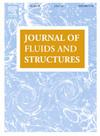Data assimilation for turbulence-merged channel branches with the simultaneous enhancement of hydrodynamics and aeroacoustics
IF 3.4
2区 工程技术
Q1 ENGINEERING, MECHANICAL
引用次数: 0
Abstract
This study explored the dynamic interplay between turbulent flow and transverse duct acoustic modes within intersecting channel branches containing two inlet branches and one outlet channel, motivated by the experimental findings of Ziada et al., 2009, entitled “Flow-acoustic coupling in T-junctions: effect of T-junction geometry” in J. Press. Vessel Technol. 131(4) and the work of Salt et al. 2014, entitled “Aeroacoustic sources generated by flow–sound interaction in a T-junction” in J. Fluid. Struct. 51, 116–131. We specifically examined how this interaction led to the simultaneous enhancement of both hydrodynamic and aeroacoustic characteristics. Compressible large eddy simulation (LES) was implemented to solve the compressible Navier–Stokes equations, and a data-assimilated momentum loss model with physical constraints was incorporated to enhance the LES accuracy and obtain the self-sustained flow–acoustic resonance fields. We further focused on the influences of upstream flow separation on the excited resonance behaviors. The numerical results with a data-assimilation strategy agreed well with the literature and acoustic modal analysis in terms of frequency, amplitude, and fundamental waveform. Three types of unsteady flow events, characterized by shear layers, recirculation zones, and separation bubbles, were identified in close response to the excited acoustic eigenmodes. The dynamics, including the acoustic-phase-resolved spatiotemporal evolution, kinematics, such as the convection trajectory and speed, and energetics, such as the aeroacoustic power sources, were further elucidated. The vertical Coriolis force, which was influenced by the secondary separation bubbles, along with the horizontal acoustic particle velocity, played a significant role in the generation of aeroacoustic power.
湍流合并通道分支的数据同化与水动力和气动声学同时增强
本研究基于Ziada et al., 2009年在J. Press发表的题为“t型结的流声耦合:t型结几何形状的影响”的实验结果,探索了包含两个进口分支和一个出口通道的相交通道分支中湍流与横向管道声学模式之间的动态相互作用。船舶技术,131(4)和Salt等人的工作,题为“t型结中流声相互作用产生的气动声源”,在J. Fluid。结构51,116-131。我们特别研究了这种相互作用如何导致水动力和气动声学特性同时增强。采用可压缩大涡模拟(LES)求解可压缩Navier-Stokes方程,并引入具有物理约束的数据同化动量损失模型,提高了大涡模拟的精度,获得了自持续流声共振场。进一步研究了上游流动分离对激波共振行为的影响。采用数据同化策略的数值结果在频率、幅度和基波方面与文献和声模态分析一致。剪切层、再循环区和分离气泡三种非定常流场与受激声特征模态的响应密切相关。进一步阐明了声相分辨时空演化的动力学、对流轨迹和速度等运动学以及气动声动力源等能量学。受二次分离气泡影响的垂直科里奥利力和水平声粒子速度对气动声功率的产生有重要影响。
本文章由计算机程序翻译,如有差异,请以英文原文为准。
求助全文
约1分钟内获得全文
求助全文
来源期刊

Journal of Fluids and Structures
工程技术-工程:机械
CiteScore
6.90
自引率
8.30%
发文量
173
审稿时长
65 days
期刊介绍:
The Journal of Fluids and Structures serves as a focal point and a forum for the exchange of ideas, for the many kinds of specialists and practitioners concerned with fluid–structure interactions and the dynamics of systems related thereto, in any field. One of its aims is to foster the cross–fertilization of ideas, methods and techniques in the various disciplines involved.
The journal publishes papers that present original and significant contributions on all aspects of the mechanical interactions between fluids and solids, regardless of scale.
 求助内容:
求助内容: 应助结果提醒方式:
应助结果提醒方式:


